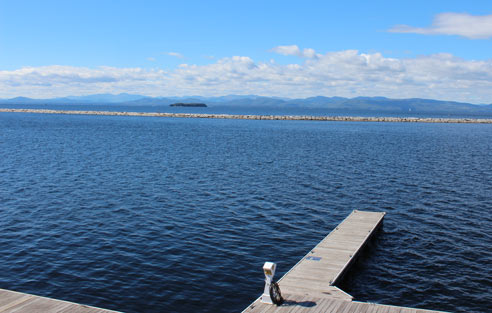News Release: Research puts price tag on clean water
Algae blooms, cloudy water can hurt home prices, tourism and jobs

Grand Isle, VT – New University of Vermont and Lake Champlain Basin Program research puts a hefty price tag on Lake Champlain’s natural beauty.
According to the study, Vermont lakeside communities would lose $16.8 million in economic activity and 200 full-time jobs – in July and August alone – for every one-meter (three-foot) decrease in water clarity.
The study is the first to investigate the relationship between home values, tourism and Lake Champlain’s visual appearance, which is regularly impacted by algae blooms, nutrient runoff, sewage and other pollutants.
Crunching five years of data, the scientists found that lake-related tourism – including restaurants, hotels and recreation services – faces a $12.6 million drop in direct summer expenditures for every meter decline in water clarity.
The team also estimated how lake amenities impact home prices in lakeside counties. Using Vermont tax data, they found a one-meter drop in water clarity yielded a 37 percent depreciation for seasonal homes, and a three percent loss for year-round single family homes.
For a $300,000 property near the lake, that’s a $9,000 loss for year-round homes, and a $111,000 loss for seasonal homes.
The research, led by UVM’s Brian Voigt, was announced today in partnership with the Lake Champlain Basin Program (LCBP).
Economic risks justify action
“These findings show that water quality in Lake Champlain and its surrounding basin is more than just an environmental concern,” says Voigt, a researcher at UVM’s Gund Institute and Rubenstein School. “It’s a major economic issue that affects homeowners, businesses and employees.”
Voigt says that quantifying Lake Champlain’s water woes gives state and federal leaders economic data to justify investments in solutions.
The results suggest that meeting new Total Maximum Daily Load (TMDL) standards could help to prevent these significant economic losses and trigger new economic benefits for Vermonters, said Eric Howe, Director of the LCBP.
The study focused on the Vermont lakeside counties of Chittenden, Addison, Franklin and Grand Isle.
Researchers paired data on lake clarity from LCBP’s Lake Champlain Long-Term Water Quality Monitoring Project with local, state and national economic data.
“We focused on water clarity, because people have a visceral reaction to it,” says Voigt. “If you take your family swimming, you might not know what excess phosphorus means. But chances are you will avoid an algae bloom.”
Study coauthors include UVM economist Jon Erickson and College of Arts and Sciences student Julia Lees, supported by the National Science Foundation’s Research Experiences for Undergraduates (REU) program.
Contact:
Brian Voigt, Gund Institute for Ecological Economics, University of Vermont, 802-656-2906
Eric Howe, Director, Lake Champlain Basin Program, 802-372-3213